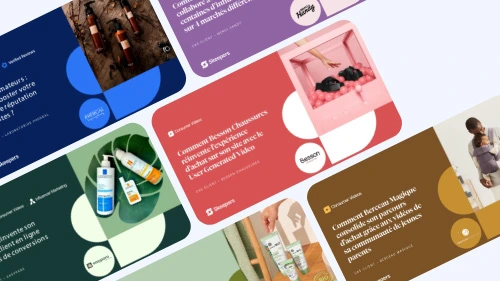Get a demo to discover one of our 6 solutions for UGC!
EN – Demo Resources
Resources
 Blog
Blog
 Improve customer loyalty
Improve customer loyalty
 With Meta’s ad-free paid subscription, UGC becomes even more valuable
With Meta’s ad-free paid subscription, UGC becomes even more valuable
With Meta’s ad-free paid subscription, UGC becomes even more valuable
 6
mn
6
mn

Meta now offers Facebook and Instagram users ad-free paid subscriptions. Meaning that the reach and performance of traditional advertising campaigns on these social media platforms will inevitably decrease in the coming months.
This revolution in the world of digital marketing is forcing brands to rethink their strategy and build new approaches to promoting their products on social media.
The solution to the fall of advertising? UGC (User Generated Content). Customer reviews, consumer videos, and posts by micro- and nano-influencers are becoming the main vectors for promoting products across all channels (websites, social media platforms, ad campaigns, etc.). Brands are using UGC more and more and this is only the beginning.
This article takes a look at Meta’s recent announcements and the new UGC trend.
Meta launches ad-free subscriptions on Facebook and Instagram
Meta has officially unveiled ad-free paid subscriptions for Facebook and Instagram. These plans will be rolled out in November in the European Economic Area and Switzerland (31 countries).
What is the main reason for this new policy? Regulatory compliance. Launching paid subscriptions enables Meta to align with a new European regulation coming into force on March 6, 2024 (Digital Market Act) and the General Data Protection Regulation (GDPR).
The impact on consumers
Consumers will have a choice: continue to use Facebook and Instagram for free with ads, or subscribe for an ad-free experience.

The monthly subscription price is set at €9.99. This price goes up to €12.99 per month if you subscribe on your mobile. This price difference is due to the fees charged by Apple and Google.
Subscriptions apply to user accounts, which are identified by an email address. Users who have the same Facebook and Instagram login won’t have to pay for two subscriptions.
The impact of this news on advertisers
The potential ad campaign audience on Instagram and Facebook will decrease, meaning that ads won’t reach as far or be as effective.
It’s difficult to estimate how many users will pay for these ad-free subscriptions, of course, but this is the main consequence for advertisers.
All advertisers will be impacted by the launch of ad-free subscriptions on Facebook and Instagram. Brands are facing a new challenge and need to explore new approaches. This is where User-Generated Content or UGC comes into play. Let’s take a look at how you can turn this seemingly bad news into a more effective acquisition strategy on social media.
Advertising is dead, long live UGC!
Understanding UGC or User-Generated Content
UGC, or User Generated Content, refers to all content created by consumers about a brand or a product. UGC encompasses a wide array of formats, from texts, reviews, ratings, and comments, from consumer photos and videos posted on social media, to Live Shopping sessions…
UGC is a marketing strategy based on consumers’ authenticity and spontaneity. This is their key strength and the main driver of their success.
Customers see UGC as more reliable and authentic than traditional marketing messages, creating a relationship of trust between brands and their audiences. This authenticity is particularly valuable today, when consumers are more and more skeptical of traditional ads, and listen even more to peer reviews.
We’ve been preaching the benefits for brands of investing in authentic content, rather than focusing on ad campaigns with an uncertain ROI, for several years now. Meta’s news only reinforces this message.
The rising power of UGC
The rise in UGC is mainly due to changes in consumer behavior. Consumers today are tired of seeing ads everywhere. This advertising fatigue makes brand messages less impactful.
However, several figures show how important UGC has become in the purchasing process:
- 8 out of 10 consumers say that UGC strongly influences their purchasing decisions (Source: Blog du Modérateur).
- 88% of consumers check the product reviews before making a purchase.
- UGC publications generate 6.9 times more engagement on social media platforms than brand publications.
UGC is based on authentic and relevant content, which is an increasingly decisive factor for consumers.
Choosing UGC means opting for a more authentic and collaborative marketing style, that is more in tune with consumer expectations and, ultimately, more effective.
3 benefits of using UGC for brands
Brands benefit in several ways by adopting UGC:
- UGC generates trust: using UGC is a powerful way of showing that the brand accepts both positive and negative feedback. This builds a relationship of trust with consumers, demonstrating that the brand values and respects all its customers’ opinions.
- UGC generates engagement: UGC gets users actively involved with the brand. It fosters the creation of an engaged community. This ongoing interaction between brands and their audiences via UGC strengthens their relationship and can turn consumers into brand ambassadors.
- UGC boosts conversion: UGC has a direct impact on sales. As discussed above, it plays a key role in the buying journey. UGC is authentic, influencing consumer purchasing decisions more than traditional ads. By leveraging user-generated content, you can reduce your marketing costs while increasing your sales. The result? A much higher ROI than traditional advertising campaigns.
4 tips for shaping your UGC marketing strategy
There are several steps to follow when defining a UGC-focused marketing strategy on social media. We’re currently working on a guide detailing each of these steps, that we’ll publish shortly. Meanwhile, here are 4 tips for building your strategy:
- Define and prioritize your goals: do you want to increase engagement? Promote your products? Create a community? Improve brand awareness? Start by clarifying and prioritizing your goals.
- Think omnichannel: UGC is not limited to social media. The content can be used on your website, in your communications, or in physical stores. Take the time to think about all the ways you can use UGC.
- Leverage the various social media platform formats: UGC (customer reviews or [consumer videos]) can be shared in stories, posts, and reels. Take advantage of these different formats and explore all the possibilities. Get familiar with Familiarize yourself with the basic codes and conventions of social media if you haven’t already.
- Choose the right tools: you need tools to encourage consumers to create content, monitor UGC, analyze it, and publish it. Skeepers offers several solutions centered around UGC management: Consumer Video to produce real consumer videos, Ratings & Reviews to collect verified customer reviews about your brand and products, etc. Feel free to reach out to find out more. We’d be happy to discuss your project with you and introduce you to our solutions!
Conclusion
Meta’s introduction of ad-free subscription plans on Facebook and Instagram marks a turning point in the world of digital marketing. This development further reflects the decline of traditional advertising that is mirrored by the emergence of User Generated Content (UGC) as an alternative solution.
[UGC is emerging as a new driver of influence]. The UGC trend is a response to advertising overwhelm and modern consumers’ search for authenticity. UGC’s influence on purchasing decisions has never been greater, and it’s growing all the time. And we believe that this is just the beginning.
Brands that know how to embrace UGC will pull ahead of the competition. We can help you make the most of User Generated Content. Feel free to contact us to share your challenges and find out more about our UGC solutions.
Interested in finding out more?
Hear What Matters.
Act with Impact.
Book a demo to see how unified reviews and feedback can fuel smarter decisions, stronger connections, and serious growth.















